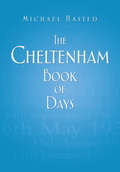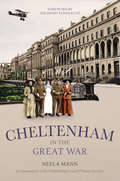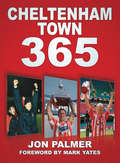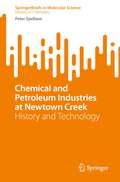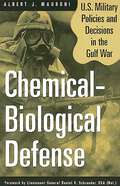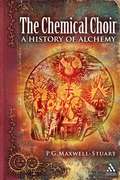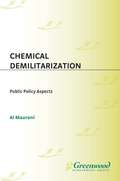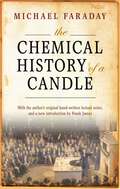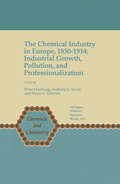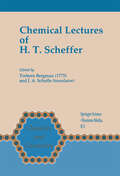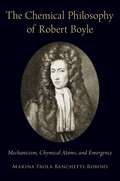- Table View
- List View
The Cheltenham Book of Days (Book Of Days Ser.)
by Michael HastedTaking you through the year day by day, The Cheltenham Book of Days contains quirky, eccentric, amusing and important events and facts from different periods of history, many of which had a major impact on the religious and political history of Britain as a whole. Ideal for dipping into, this addictive little book will keep you entertained and informed. Featuring hundreds of snippets of information gleaned from the vaults of Cheltenham’s archives, it will delight residents and visitors alike.
Cheltenham in the Great War
by Neela MannCheltenham in the Great War is the first book to portray the town, its people and the impact of the ‘war to end all wars’ from the declaration of war in 1914 to Armistice Day in 1918. Almost 1,000 Cheltenham women left by train every day for munitions work, hundreds made airplanes in the Winter Gardens, many were nurses and most former suffragettes joined the WVR. Why did two schools do double shifts and for what did the townspeople raise £186,000 in one week in 1918? How did Cheltenham cope with 7,250 soldiers billeted in the town and ‘khaki fever’? This book gives an insight into the lives of different social classes in Cheltenham – including stories of remarkable women – and how their war was fought on the Home Front. The Great War story of Cheltenham is told through considerable new research and is vividly illustrated throughout with evocative, informative images, many of which have not been published previously.
Cheltenham Town 365
by Jon PalmerThis comprehensive book will evoke memories of all the landmark matches, pivotal departures and arrivals, and significant events since the Robins first took to the field in the late nineteenth century. Compiled by the Gloucestershire Echo's football writer and lifelong Robins fanatic Jon Palmer, all the key moments are accounted for, along with cult heroes, loyal servants, classic cup ties, promotions and relegations. A must-read for fans of Cheltenham Town, this book will educate even the most dedicated football ‘statto’, and will teach you everything you need to know about a club which has progressed so far in recent years, chronicling the events that led to their remarkable rise to the Football League.
Chemical and Petroleum Industries at Newtown Creek: History and Technology (SpringerBriefs in Molecular Science)
by Peter SpellaneThis book constructs a history of Newtown Creek’s industrial expansion during the period that began in the 1840s and continued through the early years of the 20th century. In that period, the production of reagent chemicals and refined materials near the center of modern-day New York City grew steadily, as practitioners, alert to European advances in chemical science, developed and applied increasingly sophisticated technologies. Innovations in methods of production, ready access to domestic and international markets, and sustained growth in volumes of production at Newtown Creek in the late 19th century had profound consequences for the practice of industrial chemistry in the United States and for the economic vitality of the City of New York. Industrial practice progressed from the recovery of animal tissues to the refining of crude petroleum and the production of high-purity copper and other metals from mineral ores. With attention to each company’s technical expertise and principal products, this book examines the interdependence of the chemicals- and materials-producing industries that thrived along Newtown Creek’s shores. The author recounts Newtown Creek’s industrial history alongside the stories of well-known New Yorkers – Peter Cooper, Charles Pratt, John D. and William Rockefeller – and other less celebrated or less notorious characters. This book provides a valuable account of New York’s history in the manufacture of reagent chemicals and refined fuels and metals and will appeal to researchers, scholars and historians interested in the early years of industrial chemistry.
Chemical-Biological Defense: U.S. Military Policies and Decisions in the Gulf War (Non-ser.)
by Albert J. MauroniThe Gulf War has been the only conflict in the last half-century that featured the possible use of chemical-biological weapons against U.S. forces. Vulnerability to such an attack spurred the Department of Defense to action from the first hint of trouble in August 1990 through the end of hostilities in March 1991. Nearly disbanded in 1972, the U.S. Army Chemical Corps would be the prime force in ensuring that U.S. forces could both survive and sustain combat operations under chemical-biological warfare conditions. Focussing on the work of senior Army officials, this account assesses the degree of readiness achieved by the ground war's initiation and the lessons learned since the conflict.For an appropriately trained and equipped military force, chemical weapons pose not the danger of mass destruction but the threat of mass disruption, no more deadly than smart munitions or B-52 air strikes. This book will reveal a coordinated response to train and equip U.S. forces did take place prior to the feared Iraqi chemical and biological attacks. Undocumented in any other book, it details the plans that rushed sixty Fox reconnaissance vehicles to the Gulf, the worldwide call for protective suits and masks, and the successful placement of biological agent detectors prior to the air offensive. In addition, the work addresses what really happened at Khamisiyah. Were troops exposed to chemical weapons and what is behind the mysterious Gulf War Syndrome?
The Chemical Choir: A History of Alchemy
by P. G. Maxwell-StuartP.G. Maxwell-Stuart presents the history of alchemy traced from its earliest roots through to its influence in modern-day science.
The Chemical Choir: A History of Alchemy
by P. G. Maxwell-StuartP.G. Maxwell-Stuart presents the history of alchemy traced from its earliest roots through to its influence in modern-day science.
Chemical Demilitarization: Public Policy Aspects (Non-ser.)
by Albert J. MauroniFor more than 15 years, the Army's chemical demilitarization program has been criticized and castigated as a potentially dangerous effort, poorly executed without concern for the public. By reviewing the chemical demilitarization program as a public policy area, Mauroni offers a different perspective on how the Army worked with Congress and the public to offer the safest program possible. The Army was forced to delay its own schedule and increase the breadth and depth of the program to address political demands and idealistic environmental concerns. Mauroni contends that Army and Department of Defense leadership's insistence on treating this program as a strictly technical effort, rather than as a public policy concern is in part responsible for the public's misunderstanding of the Army's execution of the program.Despite its challenges, the Army is well on its way to accomplishing its goal of destroying the U.S. chemical weapons stockpile with no impact on the public or environment. They have stumbled through, however, rather than planned their exit. According to Mauroni, the Army needs to examine this program carefully to identify how to address public policy questions better in the future, to include responding to chemical and biological terrorism, developing a biological warfare vaccine program, and addressing future Gulf War illness questions. Their failure to learn will otherwise result in a continued inability to address critical questions on how they respond to chemical and biological warfare issues.
The Chemical History of a Candle: With an Introduction by Frank A.J.L. James
by Michael FaradayMichael Faraday's celebrated series of lectures,The Chemical History of a Candle, turned into one of the most successful science books ever published and was a classic work of Victorian popular science. They also reflect how Faraday, the bookbinder's apprentice turned scientist, was a remarkable communicator of science. First published in 1861 they have remained continuously in print ever since. Covering a wide range of basic scientific knowledge, much of which still has relevance today, The Chemical History of a Candle draws out the science behind the candle flame; a familiar yet complex example of combustion, and a source of fascination as much today as it was then. Timed to mark the 150th anniversary of the first publication, Frank James presents a new edition of the lectures, which, for the first time, includes a facsimile of Faraday's original handwritten lecture notes, never before published. Including an introduction from Frank James this new edition provides the historical context and background to his lectures, and to Faraday himself.
The Chemical History of a Candle: With an Introduction by Frank A.J.L. James
by Michael FaradayMichael Faraday's celebrated series of lectures,The Chemical History of a Candle, turned into one of the most successful science books ever published and was a classic work of Victorian popular science. They also reflect how Faraday, the bookbinder's apprentice turned scientist, was a remarkable communicator of science. First published in 1861 they have remained continuously in print ever since. Covering a wide range of basic scientific knowledge, much of which still has relevance today, The Chemical History of a Candle draws out the science behind the candle flame; a familiar yet complex example of combustion, and a source of fascination as much today as it was then. Timed to mark the 150th anniversary of the first publication, Frank James presents a new edition of the lectures, which, for the first time, includes a facsimile of Faraday's original handwritten lecture notes, never before published. Including an introduction from Frank James this new edition provides the historical context and background to his lectures, and to Faraday himself.
The Chemical Industry in Europe, 1850–1914: Industrial Growth, Pollution, and Professionalization (Chemists and Chemistry #17)
by Ernst Homburg Anthony S. Travis Harm G. SchröterEurope is the cradle of the modem international chemical industry. From the middle of the nineteenth century until the outbreak of World War I, the European chemical industry influenced not only the production and control of science and technology, but also made significant contributions towards economic development, as well as bringing about profound changes in working and living enviromnents. It is a highly complex heritage, both rich and threatening, that calls for close scrutinity. Fortunately, a unique opportunity to explore the historical development of the European chemical industry from a variety of novel standpoints, was made possible during 1993 as part of the European Science Foundation (ESF) programme called 'The Evolution of Chemistry in Europe, 1789-1939.' This process of exploration has taken place through three workshops, each dealing with different time periods. The workshop concerned with the period 1850-1914, which corresponds roughly to the so-called Second Industrial Revolution, was held in Maastricht, The Netherlands, on 23-25 March 1995. This volume is the outcome of that workshop. The other workshops dealing with European chemical industry were held in Liege in 1994, covering the First Industrial Revolution period, 1789-1850, and Strasbourg in 1996, covering the period between the two World Wars.
The Chemical Philosophy of Robert Boyle: Mechanicism, Chymical Atoms, and Emergence
by Marina Paola Banchetti-RobinoRobert Boyle (1627-1691) believed that a reductionist conception of the mechanical philosophy threatened the heuristic power and autonomy of chemistry as an experimental science. While some historical and philosophical scholars have examined his nuanced position, understanding the chemical philosophy he developed through his own experimental work is incredibly difficult even for experts in the field. In The Chemical Philosophy of Robert Boyle, Marina Paola Banchetti-Robino energetically explains Boyle's ideas in a whole new light and proposes that Boyle regarded chemical qualities as non-reducible dispositional and relational properties that emerge from, and supervene upon, the mechanistic structure of chymical atoms. Banchetti-Robino demonstrates that these ideas are implicit in Boyle's writing, making his philosophical contributions crucial to the fields of both philosophy and chemistry. The arguments presented are further strengthened by a detailed mereological analysis of Boylean chymical atoms as chemically elementary entities, which establishes the theory of wholes and parts that is most consistent with an emergentist conception of chemical properties. More generally, this book examines the way in which Boyle sought to accommodate his complex chemical philosophy within the framework of the 17th century mechanistic theory of matter. Banchetti-Robino conceptualizes Boyle's experimental work as a scientific research programme, in the Lakatosian sense, to better explain the positive and negative heuristic function of the mechanistic theory of matter within his chemical philosophy. The Chemical Philosophy of Robert Boyle actively engages with the contemporary and lively debates over the nature of Boyle's ideas about structural chemistry, fundamental mechanistic particles and properties, the explanatory power of subordinate causes, the complex relation between fundamental particles, natural kinds, and unified chemical wholes. The book is a rich historical account that begins with the dominant paradigms of 16th and 17th Century chemical philosophy and takes readers all the way through to the 21st Century.
The Chemical Philosophy of Robert Boyle: Mechanicism, Chymical Atoms, and Emergence
by Marina Paola Banchetti-RobinoRobert Boyle (1627-1691) believed that a reductionist conception of the mechanical philosophy threatened the heuristic power and autonomy of chemistry as an experimental science. While some historical and philosophical scholars have examined his nuanced position, understanding the chemical philosophy he developed through his own experimental work is incredibly difficult even for experts in the field. In The Chemical Philosophy of Robert Boyle, Marina Paola Banchetti-Robino energetically explains Boyle's ideas in a whole new light and proposes that Boyle regarded chemical qualities as non-reducible dispositional and relational properties that emerge from, and supervene upon, the mechanistic structure of chymical atoms. Banchetti-Robino demonstrates that these ideas are implicit in Boyle's writing, making his philosophical contributions crucial to the fields of both philosophy and chemistry. The arguments presented are further strengthened by a detailed mereological analysis of Boylean chymical atoms as chemically elementary entities, which establishes the theory of wholes and parts that is most consistent with an emergentist conception of chemical properties. More generally, this book examines the way in which Boyle sought to accommodate his complex chemical philosophy within the framework of the 17th century mechanistic theory of matter. Banchetti-Robino conceptualizes Boyle's experimental work as a scientific research programme, in the Lakatosian sense, to better explain the positive and negative heuristic function of the mechanistic theory of matter within his chemical philosophy. The Chemical Philosophy of Robert Boyle actively engages with the contemporary and lively debates over the nature of Boyle's ideas about structural chemistry, fundamental mechanistic particles and properties, the explanatory power of subordinate causes, the complex relation between fundamental particles, natural kinds, and unified chemical wholes. The book is a rich historical account that begins with the dominant paradigms of 16th and 17th Century chemical philosophy and takes readers all the way through to the 21st Century.
Chemical Protective Clothing: Permeation and Degradation Compendium (Routledge Revivals)
by Krister Forsberg Lawrence H. KeithFirst Published in 1995. The three most important things to evaluate when selecting Chemical Protective Clothing (CPC) are: evidence of degradation of the garment exposed to a chemical; breakthrough time; and permeation rate. Because proper CPC selection must be based on permeation and degradation tests performed upon specific manufacturer products, an information source that enables you to access test results quickly and easily is needed. "Chemical Protective Clothing Permeation and Degradation Compendium" aims to be that source.
Chemical Protective Clothing: Permeation and Degradation Compendium (Routledge Revivals)
by Krister Forsberg and Lawrence H. KeithFirst Published in 1995. The three most important things to evaluate when selecting Chemical Protective Clothing (CPC) are: evidence of degradation of the garment exposed to a chemical; breakthrough time; and permeation rate. Because proper CPC selection must be based on permeation and degradation tests performed upon specific manufacturer products, an information source that enables you to access test results quickly and easily is needed. "Chemical Protective Clothing Permeation and Degradation Compendium" aims to be that source.
Chemical Warfare: A Study in Restraints (PDF)
by Frederic Joseph BrownWhy would a nation, in the midst of a vicious and unrestricted war, hesitate to employ a weapon guaranteed to inflict massive casualties on the enemy? Major Frederic Brown offers here the first critical analysis of this curious World War II phenomenon. He investigates the nature of restraints-political, military, economic, and psychological-operative in varying degrees between 1919 and 1945, when U.S. chemical warfare policy was being formed. Starting with the experiences of toxic agent use during World War I, Major Brown shows how various restraints to gas warfare developed during the inter-war years. He then discusses the World War II experience. In the conclusion Major Brown relates his findings to contemporary conflicts and offers important implications for the future of the cold war.Originally published in 1968.The Princeton Legacy Library uses the latest print-on-demand technology to again make available previously out-of-print books from the distinguished backlist of Princeton University Press. These editions preserve the original texts of these important books while presenting them in durable paperback and hardcover editions. The goal of the Princeton Legacy Library is to vastly increase access to the rich scholarly heritage found in the thousands of books published by Princeton University Press since its founding in 1905.
Chemical Warfare: A Study in Restraints
by Fredric BrownIn the aftermath of 9/11, the potential terror of weapons of mass destruction--from nuclear, biological, and chemical to dirty bombs--preoccupies national security experts. In Chemical Warfare, Frederic J. Brown, presents a cogent, innovative framework for understanding the historical forces that have restrained the use of WMD and how they continue to have relevance today. Analyzing both world wars, he argues that the restraints on use were complex and often unpredictable and ranged from the political to the technological. The author offers a detailed examination of American chemical warfare policy as it was shaped by industry and public sentiment, as well as national and military leaders. The organization of the book into three parts reflects the importance of battlefield experiences during the First World War and of international political restraints as they evolved during the interwar years and culminated in ""no first use"" policies by major powers in World War II. Part I examines the use of chemical weapons in World War I as it influenced subsequent national policy decisions. Part II focuses on the evolution of political, military, economic, and psychological restraints from 1919 to 1939. Part III discusses World War II during two critical periods: 1939 to early 1942, when the environment of the war was being established largely without American influence; and during 1945, when the United States faced no credible threat of retaliation to deter its strategic and battlefield use of chemical weapons. Written at the height of controversy about the U.S. use of chemicals in Vietnam, Chemical Warfare offers a valuable historical perspective, as relevant now in its analysis of chemical and also nuclear policy as it was when first published.
Chemical Warfare: A Study in Restraints
by Fredric BrownIn the aftermath of 9/11, the potential terror of weapons of mass destruction--from nuclear, biological, and chemical to dirty bombs--preoccupies national security experts. In Chemical Warfare, Frederic J. Brown, presents a cogent, innovative framework for understanding the historical forces that have restrained the use of WMD and how they continue to have relevance today. Analyzing both world wars, he argues that the restraints on use were complex and often unpredictable and ranged from the political to the technological. The author offers a detailed examination of American chemical warfare policy as it was shaped by industry and public sentiment, as well as national and military leaders. The organization of the book into three parts reflects the importance of battlefield experiences during the First World War and of international political restraints as they evolved during the interwar years and culminated in ""no first use"" policies by major powers in World War II. Part I examines the use of chemical weapons in World War I as it influenced subsequent national policy decisions. Part II focuses on the evolution of political, military, economic, and psychological restraints from 1919 to 1939. Part III discusses World War II during two critical periods: 1939 to early 1942, when the environment of the war was being established largely without American influence; and during 1945, when the United States faced no credible threat of retaliation to deter its strategic and battlefield use of chemical weapons. Written at the height of controversy about the U.S. use of chemicals in Vietnam, Chemical Warfare offers a valuable historical perspective, as relevant now in its analysis of chemical and also nuclear policy as it was when first published.
Chemical Warfare during the Vietnam War: Riot Control Agents in Combat
by D. Hank EllisonChemical Warfare during the Vietnam War documents the use of antipersonnel chemical weapons throughout the Vietnam War, and explores their effectiveness under the wide variety of circumstances in which they were employed. The short, readable account follows the US program as it progressed from a focus on the humanitarian aspects of non-lethal weapons to their use as a means of augmenting and enhancing the lethality of traditional munitions. It also presents the efforts of the North Vietnamese to both counter US chemical operations and to develop a chemical capability of their own. Chemical Warfare during the Vietnam War is a comprehensive and thoroughly fascinating examination of riot-control agents during the Vietnam War.
Chemical Warfare during the Vietnam War: Riot Control Agents in Combat
by D. Hank EllisonChemical Warfare during the Vietnam War documents the use of antipersonnel chemical weapons throughout the Vietnam War, and explores their effectiveness under the wide variety of circumstances in which they were employed. The short, readable account follows the US program as it progressed from a focus on the humanitarian aspects of non-lethal weapons to their use as a means of augmenting and enhancing the lethality of traditional munitions. It also presents the efforts of the North Vietnamese to both counter US chemical operations and to develop a chemical capability of their own. Chemical Warfare during the Vietnam War is a comprehensive and thoroughly fascinating examination of riot-control agents during the Vietnam War.
Chemical Warrior: Syria, Salisbury and Saving Lives at War
by Hamish de Bretton-GordonGRIPPING, MOVING AND INSPIRING: the remarkable life of a world-leading expert in chemical weapons defence. "His work has saved lives and given hope." - Professor David Nott, bestselling author of War DoctorFor thirty years, Hamish has served and volunteered in conflict zones around the world. As the army's foremost chemical weapons expert, he built a unique first-hand understanding of how to prevent attacks and train doctors on the frontline - saving countless lives in the process. After suffering near-death experiences time and again, Hamish discovered he had a ticking time bomb in his own chest: a heart condition called Sudden Death Syndrome that could kill him at any time. But with a new awareness for the fragility of life, he fought harder to make his count.Despite facing extraordinary personal danger, Hamish has unearthed evidence of multiple chemical attacks in Syria and continues to advise the government at the highest level, including after the 2018 Novichok poisoning in Salisbury. Lifting the lid on Hamish's unique world of battlefield expertise and humanitarian work, Chemical Warrior is a thrilling story of bravery and compassion.
The Chemical Works of Carl Wilhelm Scheele (SpringerBriefs in Molecular Science)
by Anders LennartsonThis brief draws on the first modern book about Carl Wilhelm Scheele which was published in Swedish in 2015. Following an introduction and bibliography of Scheele’s published works, the author analyses Scheele’s publications paragraph by paragraph, explaining the procedures and the results in modern terms, and summarising and elucidating Scheele’s conclusions. Up until now the original works by Scheele have only in part been translated into English, and to get a complete view of Scheele’s work, knowledge of both Swedish and German was required. This brief opens up the important work of Carl Wilhelm Scheele to an international audience of historians of chemistry, students of history of chemistry and interested chemists.
Chemically Imbalanced: Everyday Suffering, Medication, and Our Troubled Quest for Self-Mastery
by Joseph E. DavisEveryday suffering—those conditions or feelings brought on by trying circumstances that arise in everyone’s lives—is something that humans have grappled with for millennia. But the last decades have seen a drastic change in the way we approach it. In the past, a person going through a time of difficulty might keep a journal or see a therapist, but now the psychological has been replaced by the biological: instead of treating the heart, soul, and mind, we take a pill to treat the brain. Chemically Imbalanced is a field report on how ordinary people dealing with common problems explain their suffering, how they’re increasingly turning to the thin and mechanistic language of the “body/brain,” and what these encounters might tell us. Drawing on interviews with people dealing with struggles such as underperformance in school or work, grief after the end of a relationship, or disappointment with how their life is unfolding, Joseph E. Davis reveals the profound revolution in consciousness that is underway. We now see suffering as an imbalance in the brain that needs to be fixed, usually through chemical means. This has rippled into our social and cultural conversations, and it has affected how we, as a society, imagine ourselves and envision what constitutes a good life. Davis warns that what we envision as a neurological revolution, in which suffering is a mechanistic problem, has troubling and entrapping consequences. And he makes the case that by turning away from an interpretive, meaning-making view of ourselves, we thwart our chances to enrich our souls and learn important truths about ourselves and the social conditions under which we live.
Chemically Imbalanced: Everyday Suffering, Medication, and Our Troubled Quest for Self-Mastery
by Joseph E. DavisEveryday suffering—those conditions or feelings brought on by trying circumstances that arise in everyone’s lives—is something that humans have grappled with for millennia. But the last decades have seen a drastic change in the way we approach it. In the past, a person going through a time of difficulty might keep a journal or see a therapist, but now the psychological has been replaced by the biological: instead of treating the heart, soul, and mind, we take a pill to treat the brain. Chemically Imbalanced is a field report on how ordinary people dealing with common problems explain their suffering, how they’re increasingly turning to the thin and mechanistic language of the “body/brain,” and what these encounters might tell us. Drawing on interviews with people dealing with struggles such as underperformance in school or work, grief after the end of a relationship, or disappointment with how their life is unfolding, Joseph E. Davis reveals the profound revolution in consciousness that is underway. We now see suffering as an imbalance in the brain that needs to be fixed, usually through chemical means. This has rippled into our social and cultural conversations, and it has affected how we, as a society, imagine ourselves and envision what constitutes a good life. Davis warns that what we envision as a neurological revolution, in which suffering is a mechanistic problem, has troubling and entrapping consequences. And he makes the case that by turning away from an interpretive, meaning-making view of ourselves, we thwart our chances to enrich our souls and learn important truths about ourselves and the social conditions under which we live.
